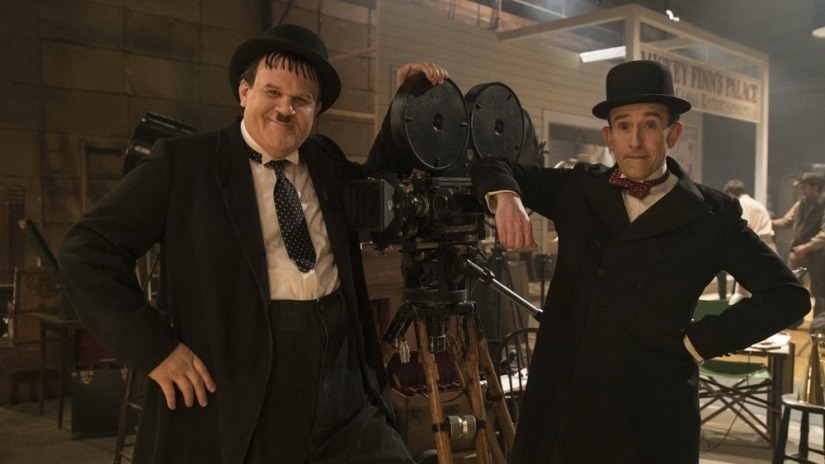It’s a late night in the study of a British hotel suite during a certain scene in Stan & Ollie, but the transatlantic travel and sleepless hours aren’t enough to squash Stan Laurel (Steve Coogan) and Oliver Hardy’s (John C. Reilly) creative juices. Now in the later stages of their careers, the pair is workshopping ideas for a Robin Hood film parody that will never come to be, but they don’t know this yet. Instead Laurel is explaining and demonstrating a sight gag involving a curtain to Hardy, who plays along until the punchline and breaks out into laughter.
There are many moments like this in Stan & Ollie, the latest from Filth director Jon S. Baird and co-writer Jeff Pope, who worked on Coogan’s Philomena. The story they’ve crafted, one billed as a familiar celebrity biopic, is as sweet as it is predictable, and moviegoers familiar with the sometimes Oscar-baiting biopic genre will recognise many of the major beats. Even so, what makes the film work are the character-driven moments in which Coogan and Reilly manage to channel Stan and Ollie with uncanny ease.
Stan & Ollie begins with a look back at the titular pair’s initial break with Hollywood mega-producer Hal Roach (Danny Huston), who helped launch their hugely popular comedy films in the 1930s and 1940s. They’re unhappy about their contract and ready to demand more money, but when the time comes to confront Roach, Hardy backs down, leaving Laurel to fend for himself. This drives a wedge between them that will later resurface in flashbacks and a penultimate confrontation in the film’s final act when they are older, wiser, and more tired.
As necessary for the story as these beats are, Stan & Ollie is less about Laurel and Hardy’s beginnings and more about the twilight of their partnership. This is where the late night brainstorming scene comes into play. The movie follows their reunion for a 1953 tour of the British Isles. Despite the efforts of a well-meaning manager (Rufus Jones), the various venues they are booked to play are barely selling any tickets. This quickly wears the pair down, almost as much as Hardy’s health problems and Laurel’s fleeting suspicion that the Robin Hood film will never happen.
Yet they persevere, and this is where the meat of the movie really is. Watching these two prepare time after time to put on many of the same popular routines from their films, traveling to the next gig and working out new material in the interim makes Stan & Ollie excel beyond its otherwise bland, genre-specific elements. Yes, there’s the long buildup to a nasty fight between Laurel and Hardy. Yes, there’s a health scare. Yes, there’s a form of reconciliation before the end credits roll. But what really works are the intimate moments these two men and, dare we say it, friends share with one another.
Consider the oft-teased trunk scene from the trailers. The pair is rushing to catch a train before it departs and struggling with the sheer amount of luggage that accompanies them. When Hardy inquires about the time, Laurel asks him to hold a trunk so that he can check his watch. Unfortunately for them, Hardy grabs the wrong piece of luggage and before Laurel can react, the trunk in question begins its fateful slide down a stairwell. Soon after it stops, the heavier and decidedly more exasperated Hardy quips, “Do we really need that trunk?”
In many ways, this scene operates as a sort of meta-play on the set pieces most often associated with their comedy films. It’s also a great way to introduce audiences to the men behind the film characters, for the real challenge in bringing them to life is figuring out how to play two parts at once. We know how the Laurel and Hardy of the Laurel and Hardy films would react in such a scenario, but what about the men themselves? Would the cerebral and witty Laurel tease his companion over the gag? Would the more curmudgeonly Hardy berate his partner for giving him the wrong suitcase?
Coogan and Reilly accomplished this feat by rehearsing the routines for over a month just to get them right. In all that time they also managed to capture both sides of their respective characters. Coogan perfects the linguistic tics and physical mannerisms of the seemingly shyer Laurel with ease, while Reilly combines the tools afforded him (a fat suit and significant prosthetics) with a strong sense of physicality and friendly tiredness to bring Hardy back to life. Their character work is so good, in fact, that it’s enough to drive the film despite its paint-by-numbers approach to this particular genre of filmmaking.
Huston’s Roach, Jones’s manager and other minor characters earn honorable mentions, of course, though a review of Stan & Ollie, regardless of its opinion, would be incomplete without mentioning Shirley Henderson and Nina Arianda’s work as Lucille Hardy and Ida Kitaeva Laurel. The former excels as Hardy’s demonstrably smaller but fiercely supportive wife. She acknowledges his longtime collaboration with Laurel, but is more than willing to defend him against his partner’s perceived penchant for overworking him. Arianda, meanwhile, gleefully chews the scenery as Laurel’s Russian wife, a woman who is seemingly independent of her husband’s needs but always down for a public fight on his behalf if necessary.
Henderson and Arianda’s performances, along with Coogan and Reilly’s as the title characters, help make Stan & Ollie seem far better than it really has any right to be. Because this is a standard Hollywood biopic that is replete with creative navel-gazing. It boasts many of the beats that audiences, especially Academy voters, have come to expect from such fanfare. In spite of such caveats, however, Stan & Ollie manages to succeed in large part because of the work that Coogan, Reilly, Henderson and Arianda have put into their performances.
Stan & Ollie opens in UK cinemas on 11 January 2019.

